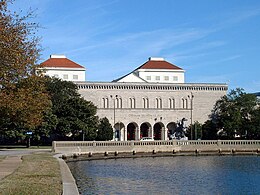Chrysler Museum of Art
 |
|
| Established | 1933 |
|---|---|
| Location | 1 Memorial Place, Norfolk, Virginia |
| Type | Art museum |
| Visitors | 150,000 |
| Director | Erik H. Neil |
| Curator | Crawford Alexander Mann III (American), Diane Wright (Glass) |
| Website | www |
|
Moses Myers House
|
|
 |
|
| Location | SW corner of E. Freemason and N. Bank Sts., Norfolk, Virginia |
|---|---|
| Coordinates | 36°51′0″N 76°17′17″W / 36.85000°N 76.28806°W |
| Area | 9.9 acres (4.0 ha) |
| Built | 1792, 1796 |
| Architect | Latrobe, Benjamin H. |
| Architectural style | Federal |
| NRHP Reference # | 70000874 |
| VLR # | 122-0017 |
| Significant dates | |
| Added to NRHP | February 16, 1970 |
| Designated VLR | December 2, 1969 |
Coordinates: 36°51′25.12″N 76°17′32.73″W / 36.8569778°N 76.2924250°W
The Chrysler Museum of Art is an art museum on the border between downtown and the Ghent district of Norfolk, Virginia. The museum was founded in 1933 as the Norfolk Museum of Arts and Sciences. In 1971, automotive heir, Walter P. Chrysler Jr. (whose wife, Jean Outland Chrysler, was a native of Norfolk), donated most of his extensive collection to the museum. This single gift significantly expanded the museum's collection, making it one of the major art museums in the Southeastern United States. From 1958 to 1971, the Chrysler Museum of Art was a smaller museum consisting solely of Chrysler's personal collection and housed in the historic Center Methodist Church in Provincetown, Massachusetts. Today's museum sits on a small body of water known as The Hague.
The museum's main building underwent expansion and renovation and reopened on May 10, 2014. During the renovation, the Glass Studio and the Moses Myers House remained open and art was displayed at venues throughout the community. The museum's grand reopening included the Rubber Duck floating sculpture from May 17–26, 2014.
The New York Times described the Chrysler collection as "one any museum in the world would kill for." Comprising over 30,000 objects, the collection spans over 5,000 years of world history. American and European paintings and sculpture from the Middle Ages to the present day form the core of the collection.
...
Wikipedia


